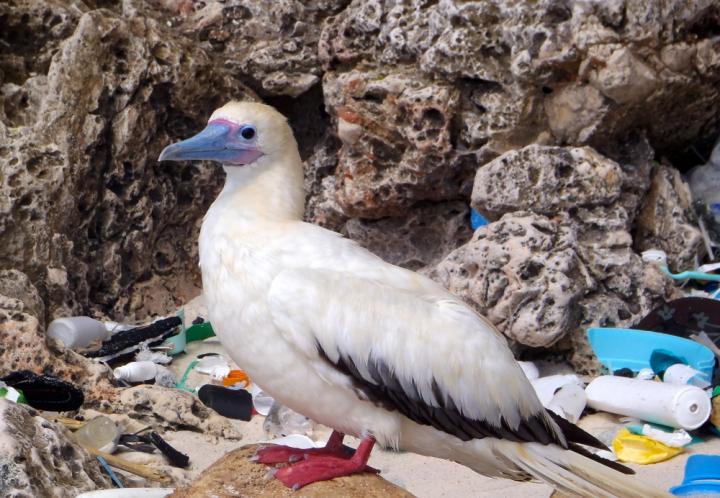Seabird SOS

On Christmas Island in the Indian Ocean a red-footed booby stands amid plastic debris. Credit: Britta Denise Hardesty
Plastic debris in the ocean has been an environmental issue for almost half a century. Now, for the first time, scientists can predict the global impact of plastics on avian marine species — and it isn't pretty.
A study published today in the Proceedings of the National Academy of Sciences estimates that 90 percent of individual seabirds alive today have consumed some form of plastic. “This is a huge amount and really points to the ubiquity of plastic pollution,” said lead author Chris Wilcox, a senior research scientist at Australia's Commonwealth Scientific and Industrial Research Organisation (CSIRO) Oceans and Atmosphere Flagship.
Wilcox also contributed to a study published earlier this year that found more than 4.8 million metric tons of plastic waste enters the oceans from land each year. Both studies were conducted by the same working group at UC Santa Barbara's National Center for Ecological Analysis and Synthesis (NCEAS) and supported by Washington, D.C.-based Ocean Conservancy.
“We've known for some time that the magnitude of plastic pollution is daunting,” said NCEAS Director Frank Davis. “This study is important in revealing the pervasive impact of that plastic on seabirds.”
The researchers found that nearly 60 percent of all seabird species, including albatrosses, shearwaters and penguins, have plastic in their guts. According to co-author Denise Hardesty, who was also a member of the NCEAS working group, seabirds are excellent indicators of ecosystem health. “Finding such widespread estimates of plastic in seabirds is borne out by some of the fieldwork we've carried out where I've found nearly 200 pieces of plastic in a single seabird,” she said.
The investigators' analysis of studies published since the early 1960s showed that plastic is increasingly common in seabirds' stomachs. In 1960, plastic was found in the stomachs of less than 5 percent of seabirds; by 2010 that figure had risen to 80 percent. Based on current trends, the scientists predict that plastic ingestion will affect 99 percent of the world's seabird species by 2050.
The plethora of plastic comes from bags, bottle caps and plastic fibers from synthetic clothes that have washed out into the ocean from urban rivers, sewers and waste deposits. Birds mistake the brightly colored items for food or swallow them by accident, causing gut impaction, weight loss and sometimes death.
According to the study, plastics will have the greatest impact on wildlife that gather in the Southern Ocean in a band around the southern edges of Australia, South Africa and South America. These areas are home to widely diverse species. While the infamous garbage patches in the middle of the oceans have higher densities of plastic, fewer birds live in these regions so the impact is reduced.
Hardesty, who works with Wilcox at CSIRO Oceans and Atmosphere, noted that the opportunity still exists to change the impact plastic has on seabirds. “Improving waste management can reduce the threat plastic is posing to marine wildlife,” she said.
“Even simple measures can make a difference,” Hardesty added. “Efforts to reduce plastics dumped into the environment in Europe resulted in measureable changes in plastic in seabird stomachs in less than a decade. This suggests that improvements in basic waste management can reduce plastic in the environment in a really short time.”
###
The work was carried out as part of a national marine debris project supported by CSIRO and Shell's social investment program as well as the marine debris working group at UCSB's NCEAS. Erik van Sebille of the Grantham Institute at Imperial College London was also a co-author.
Media Contact
All latest news from the category: Ecology, The Environment and Conservation
This complex theme deals primarily with interactions between organisms and the environmental factors that impact them, but to a greater extent between individual inanimate environmental factors.
innovations-report offers informative reports and articles on topics such as climate protection, landscape conservation, ecological systems, wildlife and nature parks and ecosystem efficiency and balance.
Newest articles

Scientists transform blood into regenerative materials
… paving the way for personalized, blood-based, 3D-printed implants. Scientists have created a new ‘biocooperative’ material based on blood, which has shown to successfully repair bones, paving the way for…

A new experimental infection model in flies
…offers a fast and cost-effective way to test drugs. Researchers at the Germans Trias i Pujol Research Institute and Hospital have reinforced their leading role in infectious disease research by…

Material developed with novel stretching properties
KIT researchers produce metamaterial with different extension and compression properties than conventional materials. With this material, the working group headed by Professor Martin Wegener at KIT’s Institute of Applied Physics…



